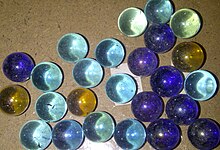
A bead is a small, decorative object that is formed in a variety of shapes and sizes of a material such as stone, bone, shell, glass, plastic, wood, or pearl and with a small hole for threading or stringing. Beads range in size from under 1 millimeter (0.039 in) to over 1 centimeter (0.39 in) in diameter.

Clarksburg is a city in and the county seat of Harrison County, West Virginia, United States, in the north-central region of the state. The population of the city was 16,039 at the 2020 census, making it the tenth-most populous city in West Virginia. It is the principal city of the Clarksburg micropolitan area, which had a population of 90,434 in 2020. Clarksburg was named National Small City of the Year in 2011 by the National League of Cities.
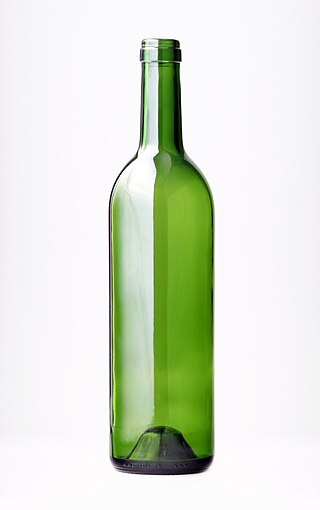
A bottle is a narrow-necked container made of an impermeable material in various shapes and sizes that stores and transports liquids. Its mouth, at the bottling line, can be sealed with an internal stopper, an external bottle cap, a closure, or induction sealing.

Hungry Hungry Hippos is a tabletop game made for 2–4 players, produced by Hasbro, under the brand of its subsidiary, Milton Bradley. The idea for the game was published in 1967 by toy inventor Fred Kroll and it was introduced in 1978. The objective is for each player to collect as many marbles as possible with their toy hippopotamus model. The game was, at one point, marketed under the "Elefun and Friends" banner, along with Elefun, Mouse Trap and Gator Golf.

In miniature wargaming, players enact simulated battles using scale models called miniature models, which can be anywhere from 2 to 54 mm in height, to represent warriors, vehicles, artillery, buildings, and terrain. These models are colloquially referred to as miniatures or minis.

Uranium glass is glass which has had uranium, usually in oxide diuranate form, added to a glass mix before melting for colouration. The proportion usually varies from trace levels to about 2% uranium by weight, although some 20th-century pieces were made with up to 25% uranium.
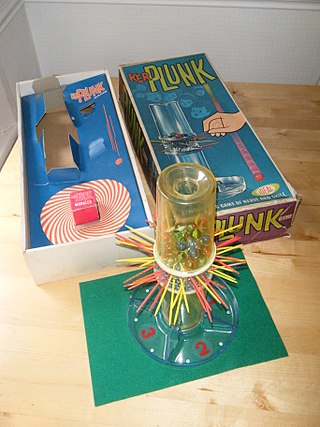
KerPlunk is a children's game invented by Eddy Goldfarb with Rene Soriano and first marketed by the Ideal Toy Company in 1967. The game consists of a transparent plastic tube, plastic rods called straws and several dozen marbles. The base contains four separate numbered trays; the straws are passed through holes in the middle of the tube to form a lattice. The marbles are then placed in the top of the tube and held in place by the lattice. The onomatopoeic name of the game derives from the sound of the marbles tumbling to the base of the tube during play.

A tessera is an individual tile, usually formed in the shape of a square, used in creating a mosaic. It is also known as an abaciscus or abaculus.

B-Daman is a marble shooting toy franchise produced in Japan by Takara. It was originally based on the Bomberman series, but later expanded into other franchises and its own original designs.

Burmese glass is a type of opaque colored art glass, shading from yellow, blue or green to pink. It is found in either the rare original "shiny" finish or the more common "satin" finish. It is used for table glass and small, ornamental vases and dressing table articles.
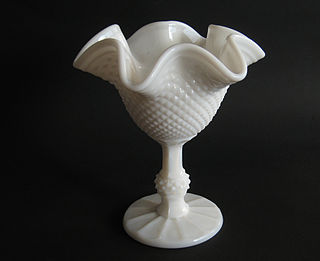
Milk glass is an opaque or translucent, milk white or colored glass that can be blown or pressed into a wide variety of shapes. First made in Venice in the 16th century, colors include blue, pink, yellow, brown, black, and white.
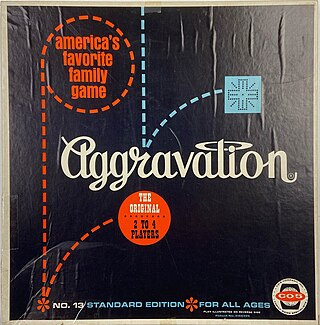
Aggravation is a board game for up to four players and later versions for up to six players, whose object is to be the first player to have all four playing pieces reach the player's home section of the board. The game's name comes from the action of capturing an opponent's piece by landing on its space, which is known as "aggravating". The name was coined by one of the creators, Louis Elaine, who did not always enjoy defeat.
Marble is a type of rock resulting from the metamorphism of limestone.

The Fenton Art Glass Company is a glass manufacturer founded in 1905 by brothers Frank L. Fenton and John W. Fenton.

Stay Alive is a strategy game, where 2-4 players try to keep their marbles from falling through holes in the game board while trying to make their opponents' marbles fall through. It was originally published by Milton Bradley in 1971 and marketed in television and print advertising as "the ultimate survival game". Stay Alive was republished with a smaller board by Winning Moves Games USA in 2005. This game is no longer in production.

A bisque doll or porcelain doll is a doll made partially or wholly out of bisque or biscuit porcelain. Bisque dolls are characterized by their realistic, skin-like matte finish. They had their peak of popularity between 1860 and 1900 with French and German dolls. Bisque dolls are collectible, and antique dolls can be worth thousands of dollars. Antique German and French bisque dolls from the 19th century were often made as children's playthings, but contemporary bisque dolls are predominantly made directly for the collectors market.

The British and World Marbles Championship is a marbles knock-out tournament that takes place annually on Good Friday and dates back to 1588. It is held at the Greyhound public house in Tinsley Green, West Sussex. Teams of six players participate to win the title and a silver trophy. The event is open to anyone of any age or nationality. Over the years, players from Australia, Belgium, Canada, Estonia, Ireland, France, Germany, Japan, Netherlands, Wales and the United States have participated alongside English teams.

Traditional Mexican handcrafted toys are those made by artisans rather than manufactured in factories. The history of Mexican toys extends as far back as the Mesoamerican era, but many of the toys date to the colonial period. Many of these were introduced as teaching tools by evangelists, and were associated with certain festivals and holidays. These toys vary widely, including cup and ball, lotería, dolls, miniature people, animals and objects, tops and more—made of many materials, including wood, metal, cloth, corn husks, ceramic, and glass. These toys remained popular throughout Mexico until the mid-20th century, when commercially made, mostly plastic toys became widely available. Because of the advertising commercial toys receive and because they are cheaper, most traditional toys that are sold as handcrafts, principally to tourists and collectors.
Martin Frederick Christensen was a Danish inventor and businessman. He is most known as the inventor of an automated machine that could manufacture glass marbles and founder of M.F. Christensen and Son Company.
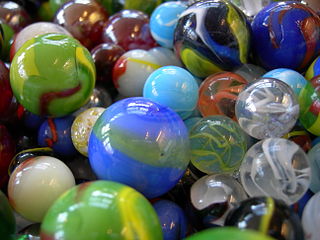
Lee's Legendary Marbles and Collectables is a museum in York, Nebraska. The museum specializes in displaying, storing and sometimes selling parts of a toy marble collection Lee Batterton amassed over 70 years. In 2023, it was officially recognized as the World's Largest Collection of Marbles.






